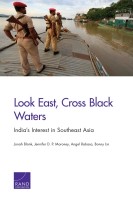| 来源类型 | Research Reports
|
| 规范类型 | 报告
|
| ISBN | 9780833089014
|
| 来源ID | RR-1021-AF
|
| Look East, Cross Black Waters: India's Interest in Southeast Asia |
| Jonah Blank; Jennifer D. P. Moroney; Angel Rabasa; Bonny Lin
|
| 发表日期 | 2015
|
| 出版年 | 2015
|
| 页码 | 316
|
| 语种 | 英语
|
| 结论 |
India's Interest in Southeast Asia Will Have a Significant Impact on U.S. Strategic Planning.- India's interest in Southeast Asia has implications for U.S. policy of "Asian rebalancing," as well as for broader U.S.-India relations — but mutual interests could lead to modest burden-sharing and potential cost-savings for the United States.
India's Goals for Southeast Asia Are in Concert with U.S. Goals for the Region.- India's big-picture goals in Southeast Asia can be encapsulated in three basic mission statements, all of them fully congruent with U.S. strategy: (1) maintain regional stability and prevent any outside power from dominating the region; (2) secure maritime lines of communication and increase connectivity infrastructure for land, sea, and air transportation; and (3) ensure that simmering territorial disputes, including South China Sea claims, are settled peacefully.
The United States Should Not Expect India to Become an "Ally," Nor to Join with the United States in an Anti-China Coalition.- India's political culture remains wary of established foreign entanglements, and distrust of the United States runs strong among Indian policymakers. Further, India sees China as only a potential threat, which will diminish its desire to ally with the United States.
The Main Difference Between U.S. and Indian Policy Toward Southeast Asia Lies Not in Direction, but in Pace and Planning- Indian policymaking is typically slow by U.S. (and other) standards, and Indian strategy is formed case by case, without an overarching framework. Further, Indian domestic constraints can weigh against policy initiatives.
|
| 摘要 |
- The United States should practice strategic patience — constantly seek to increase its cooperation, but at a pace comfortable to India.
- The United States should prioritize cooperation with India on humanitarian assistance and disaster relief in Southeast Asia.
- The United States should streamline the procedures for technology transfer to India.
- The United States should work with India on a joint strategy for engagement with Myanmar.
- The United States should help India modernize and expand its military bases on the Andaman and Nicobar Islands.
|
| 主题 | Global Security
; India
; Southeast Asia
; United States
|
| URL | https://www.rand.org/pubs/research_reports/RR1021.html
|
| 来源智库 | RAND Corporation (United States)
|
| 资源类型 | 智库出版物
|
| 条目标识符 | http://119.78.100.153/handle/2XGU8XDN/108018
|
推荐引用方式
GB/T 7714 |
Jonah Blank,Jennifer D. P. Moroney,Angel Rabasa,et al. Look East, Cross Black Waters: India's Interest in Southeast Asia. 2015.
|
|
文件名:
|
x1495316252464.jpg
|
|
格式:
|
JPEG
|

|
文件名:
|
RAND_RR1021.pdf
|
|
格式:
|
Adobe PDF
|
除非特别说明,本系统中所有内容都受版权保护,并保留所有权利。